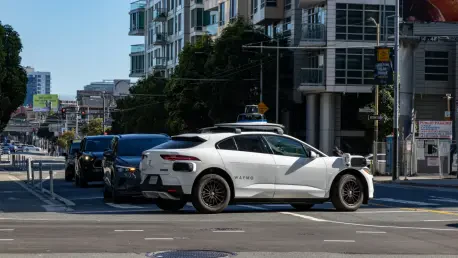In recent developments within the autonomous vehicle industry, advancements have been remarkable, with Waymo emerging as a front-runner in the self-driving sector. This innovation-driven arena is witnessing fierce competition where Waymo, a subsidiary of Alphabet, has made significant strides by achieving over 10 million paid rides. Such accomplishments highlight the company’s lead in the robotic taxi market, a space where Tesla, led by Elon Musk, is yet to establish its presence with paid rides. This evolving dynamic indicates a shift in consumer acceptance of self-driving cars, bringing new possibilities and challenges to the forefront. The landscape is being shaped by these tech giants, raising questions about the sustainability of Waymo’s leadership and the potential rise of Tesla.
A Tech-Charged Transition in Transportation
Waymo’s Expansive Growth Trajectory
Waymo has positioned itself as a trailblazer by fostering an environment conducive to the widespread adoption of autonomous vehicles. This transition is marked by Waymo’s exponential increase in service delivery, illustrating the classic technology diffusion curve. The curve narrates a journey beginning with tech enthusiasts, eventually extending to broader societal adoption, culminating in a point where autonomous vehicles become an integral transportation mode. The transformative journey is evidenced by Waymo’s remarkable service provision growth, ascending from 10,000 rides a week to an astonishing 250,000 rides per week in recent years. This surge epitomizes the burgeoning consumer acceptance and underscores the enhanced comfort driving these vehicles’ usage.
The Growing Geographic Reach
Waymo’s strategy has effectively expanded its geographic footprint to diversify its operational landscape, significantly enhancing market penetration. The company began with operations in select regions but has since broadened its territorial reach, encompassing cities like Austin, Texas. This expansion was facilitated through collaborations with established entities such as Uber. Future initiatives include anticipated longitudinal extensions into cities like Atlanta, Miami, and Washington, D.C. Additionally, Waymo is keenly exploring international arenas, with data collection initiatives in Tokyo that hint at global expansion ambitions. These strategies and market expansions slightly overshadow Tesla’s efforts, presenting Waymo as a formidable contender in the self-driving industry.
Technological Strides and Market Presence
Safety as a Cornerstone
Safety stands as a pivotal component in convincing the public about autonomous vehicles’ viability, where Waymo holds an impressive record. By amassing over 50 million driverless miles without major incidents, Waymo’s safety track record demonstrates its technological adeptness. Such achievements equate to traversing the United States approximately 20,000 times without incident, presenting a robust safety assurance. Amidst these developments, Tesla struggles to match this assurance level, partly due to challenges in achieving optimal performance in adverse conditions such as rain or snow. With safety as a critical benchmark, Waymo’s reliability becomes a significant advantage in the broader acceptance of self-driving technologies.
Economic Implications and Strategic Pricing
Waymo’s endeavors in the autonomous realm carry substantial economic implications where financial equilibrium remains a challenge. Operating at a financial loss, Waymo has invested billions into realizing its vision of autonomous transportation. The anticipation is that these initial costs will gradually decline as technology progresses and efficiencies are realized. A comparison with Tesla underscores the contrast as Waymo’s reliable technology is juxtaposed against Tesla’s underdeveloped yet less costly system. A future with more balanced pricing as autonomous systems mature is contemplated, potentially reshaping the economic landscape of self-driving technologies and making them more accessible to the masses.
A Shifting Competitive Landscape
Tesla’s Catch-Up Efforts
Elon Musk’s Tesla is perceived as lagging within the autonomous driving race. Despite Musk’s ambitious promises and Tesla’s poised inauguration of its robotaxi service, skepticism persists regarding Tesla’s ability to swiftly bridge the gap with Waymo’s technological advancements and operational experience. Waymo continues to solidify its leadership, leveraging first-mover advantages and technological milestones, leaving Tesla with a significant challenge in this evolving competitive landscape. The path to capturing market share remains complex for Tesla, with Waymo’s established presence and customer trust forming considerable barriers.
Future of Autonomous Vehicles
Waymo has established itself as a pioneer in the field of autonomous vehicles, creating an environment that promotes widespread acceptance and use. This shift is highlighted by Waymo’s remarkable growth in its service offerings, which perfectly illustrates the technology diffusion curve. This curve tells the story of how a new technology moves from early adoption by tech enthusiasts to broader acceptance by society, ultimately becoming a mainstream mode of transportation. Waymo’s transformation is evident in the significant increase in the number of rides it provides, going from just 10,000 weekly rides to an impressive 250,000 rides per week in recent years. This massive growth signifies the growing acceptance among consumers, reflecting their increased comfort and trust in using autonomous vehicles. As Waymo continues to expand, it is clear that autonomous technology is not just a futuristic concept but is rapidly becoming a crucial part of everyday transportation, demonstrating both technological advancement and shifting consumer behavior.









